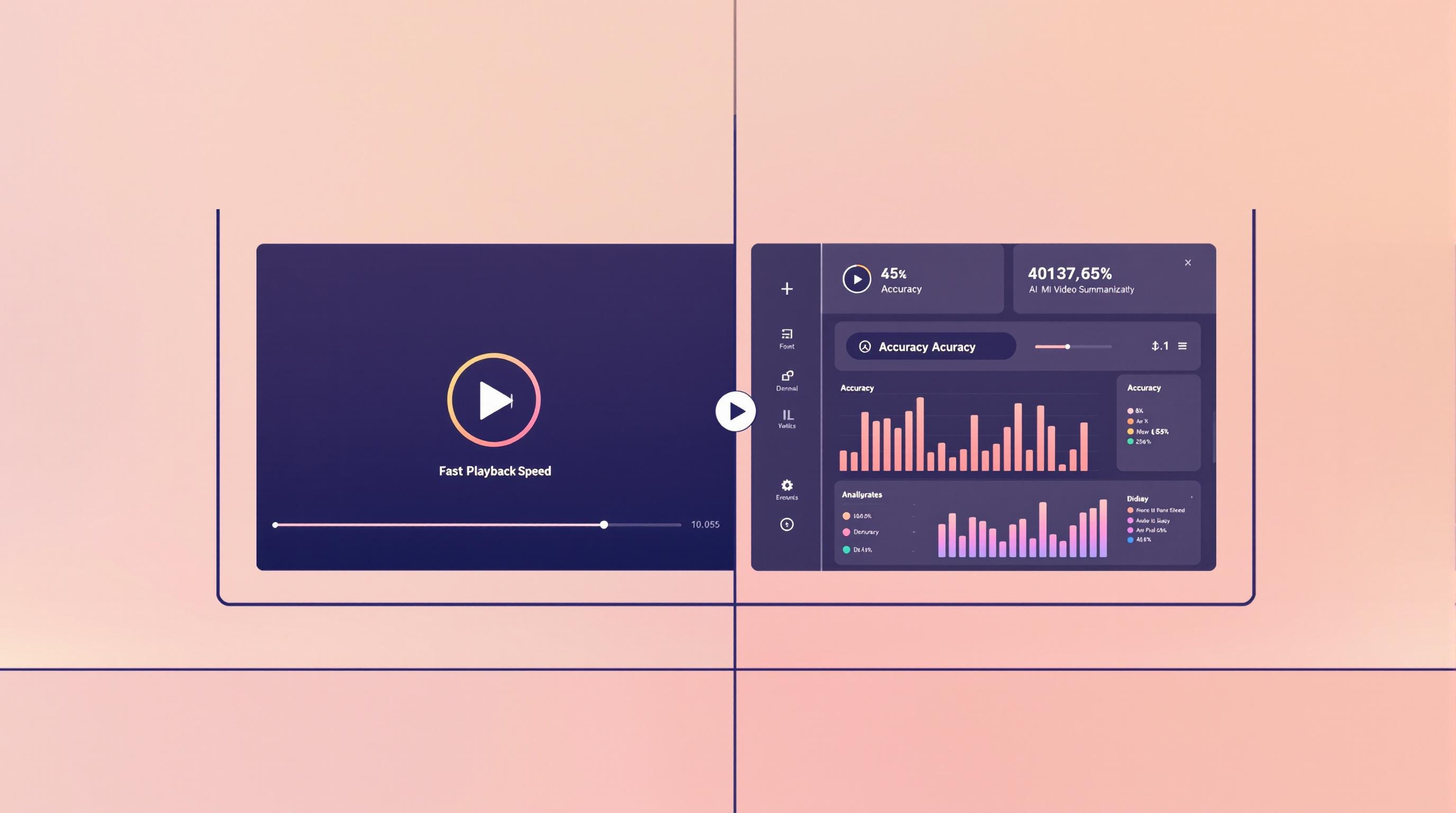Context-Aware Video Summarization (CAVS) creates smarter video summaries by analyzing time-based patterns and spatial relationships. Unlike traditional methods, it ensures events are shown in order and connected logically. This is powered by AI technologies like clustering, natural language processing (NLP), and computer vision, which identify key scenes and interactions without needing manual input.
Key Benefits of CAVS:
- Maintains the natural flow of events with temporal context.
- Highlights object and person interactions using spatial context.
- Works across fields like education, media, research, and surveillance.
Quick Overview of How It Works:
- Temporal Analysis: Detects time-based patterns to keep sequences intact.
- AI Technologies: Uses clustering, NLP, and computer vision to identify important moments.
- Applications: Breaks down lectures, creates news highlights, and improves surveillance by detecting unusual activities.
By combining unsupervised learning and multi-modal integration (audio, video, text), CAVS delivers concise, meaningful summaries for various industries. Continue reading to explore its technology, applications, and future developments.
How Context-Aware Video Summarization Works
Using Temporal Context and Video Structure
Context-aware video summarization focuses on analyzing time-based patterns to keep the flow of events intact. It uses motion detection algorithms and spatio-temporal markers to pinpoint key moments while ensuring a logical sequence is maintained. These markers act as reference points, helping the system understand how different parts of the video connect.
Sparse coding techniques are used to create feature dictionaries, which allow AI to map relationships between scenes. This ensures that summaries highlight important connections while staying cohesive. This method helps represent how video content changes and develops over time.
AI Methods in Context-Aware Summarization
Three main AI technologies drive context-aware summarization:
| Technology | Role and Purpose |
|---|---|
| Clustering | Groups similar scenes to uncover patterns and relationships |
| Natural Language Processing (NLP) | Examines narrative structure to grasp context |
| Computer Vision | Identifies objects and actions for better scene analysis |
These technologies work together to understand the relationship between time and space in videos. By using unsupervised AI methods, the system can handle various types of videos without needing pre-labeled data, making it adaptable for different scenarios.
The AI analyzes significant motion patterns and their connections to build a clear understanding of the video's content. This combined approach ensures that the final summaries are both coherent and informative, focusing on the most important sections of the original video.
These AI-powered techniques lay the groundwork for practical uses of context-aware video summarization, which will be discussed in the following sections.
Applications of Context-Aware Video Summarization
Uses in Education, Research, and Media
Context-aware video summarization has changed how educational videos are used. In academic settings, AI-powered tools break down lengthy lectures into manageable segments while keeping key learning points intact. This helps students focus on important concepts by pinpointing and highlighting essential information in educational videos.
Researchers also gain from this technology, especially when working with large volumes of video data. For example, behavioral researchers can quickly zero in on specific patterns or behaviors in hours of observation footage, saving a lot of time.
In media, these tools - using AI techniques like clustering and computer vision - help create news highlights, trailers, engaging social media content, and even select footage for documentaries. The adaptability of these tools across different domains makes them incredibly useful.
Importance in Video Surveillance
Video surveillance is one of the key areas where context-aware summarization shines. Security teams rely on this technology to efficiently monitor vast amounts of footage by automatically identifying and flagging noteworthy events. The system analyzes temporal patterns and spatial relationships to detect unusual activities or security breaches.
Some standout benefits in surveillance include:
- Real-time monitoring: Quickly identifies suspicious activities as they happen.
- Streamlined review: Reduces manual effort and provides quick access to relevant footage.
What sets this technology apart is its ability to understand the context of events and maintain their sequence over time. Instead of just detecting movement or changes, it considers the bigger picture, making it especially useful for security in commercial, public, and industrial spaces.
Recent advancements in AI that combine data types like video and audio have made these systems even better [2]. They now detect events more accurately and reduce false alarms, making them more reliable for surveillance.
As this technology evolves, new applications are constantly emerging. The goal remains to make video content easier to use and more actionable across various fields, without losing the vital context behind the footage. Choosing the right summarization tool is essential for getting the most out of this technology.
sbb-itb-26cab57
Comparing Tools for Context-Aware Video Summarization
Overview of the Video Summarizer Directory

The Video Summarizer Directory (videosummarizers.com) serves as a go-to resource for anyone looking to find tools tailored to specific video summarization needs. Whether you're in education, research, or surveillance, this platform provides a curated list of AI-based tools, categorized by their contextual analysis capabilities, supported platforms, and pricing structures.
Users can refine their search by applying filters like pricing, language support, and transcription features. The directory is regularly updated to keep pace with new advancements, making it easier to stay informed about the latest options. With this information, it's easier to assess and choose the right tool for your requirements.
Feature Comparison of Video Summarization Tools
When evaluating context-aware video summarization tools, certain features make all the difference. Key factors include the type of AI technology used, how well the tool handles temporal context, and whether it offers customization options and integration with workflows.
| Feature Category | Key Considerations | How It Affects Summarization |
|---|---|---|
| AI Technology | Deep Learning & Attention Mechanisms | Helps pinpoint key scenes and context links |
| Context Analysis | Temporal Pattern Recognition | Enhances understanding of structure |
| Multi-modal Processing | Audio, Visual, and Text Integration | Captures a fuller context |
| Customization | Adjustable Summarization Parameters | Allows tailored outputs to meet specific needs |
Advanced AI techniques, such as attention mechanisms and reinforcement learning, are particularly effective for identifying important scenes while preserving context. This is especially valuable in education, where maintaining the logical flow of concepts is crucial.
Multi-modal processing takes it a step further by integrating visual, audio, and textual data for more thorough summaries [2]. When choosing a tool, keep these factors in mind:
- Integration Options: Ensure the tool works seamlessly with your current setup, whether through APIs or plugins.
- Scalability: Check if the tool can handle larger video volumes without compromising performance.
These considerations will help you find a tool that not only meets your immediate needs but also adapts as your requirements grow.
Conclusion and Future of Context-Aware Video Summarization
Key Takeaways
Context-aware video summarization is transforming how we manage the ever-growing flood of video content. By leveraging deep learning, multi-modal processing, and temporal analysis, this technology generates concise summaries that retain the most important details from complex videos.
With the sheer volume of video content produced daily, efficient summarization has become a necessity. Advanced AI techniques are reshaping how we process and interpret videos, making them more accessible and practical for a wide range of uses.
What's Next for Video Summarization?
Several emerging technologies are shaping the future of context-aware video summarization:
| Technology Trend | Description |
|---|---|
| Unsupervised Learning | Progress in handling varied video content without relying on manual labeling. |
| Human-centric Evaluation | Better methods to assess the quality and relevance of video summaries. |
| Multi-modal Integration | Improved context analysis by combining audio, visual, and textual data. |
Researchers are working on creating more refined evaluation metrics that align closely with human perception [1]. The integration of advanced techniques like deep reinforcement learning and generative pre-trained transformers is expected to push the boundaries of video summarization [1][3]. These future systems aim to process complex video content with higher precision and adapt to a wide variety of video formats, enhancing both context detection and summary generation.
As these technologies evolve, they will tackle existing challenges, such as improving summary quality and handling diverse content types. Future systems will require less manual input, delivering more accurate and context-aware summaries. These advancements will make context-aware summarization tools even more accessible, benefiting industries like education, research, media production, and surveillance.


